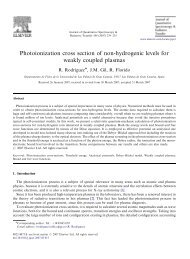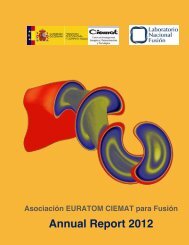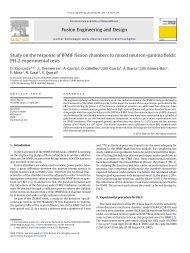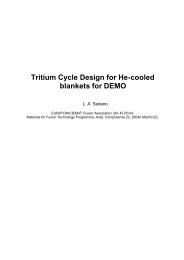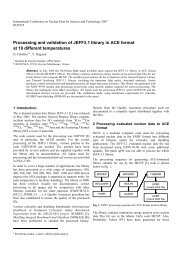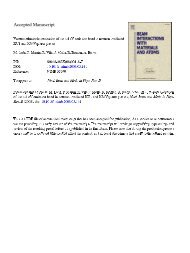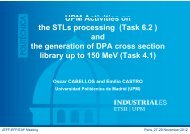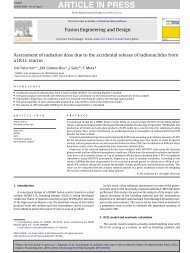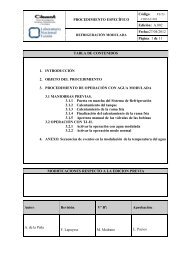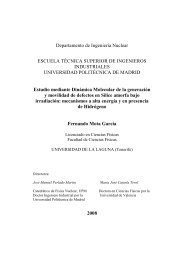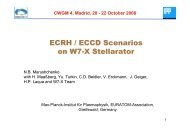Laser Driven Neutron Sources: Characteristics ... - Ciemat
Laser Driven Neutron Sources: Characteristics ... - Ciemat
Laser Driven Neutron Sources: Characteristics ... - Ciemat
You also want an ePaper? Increase the reach of your titles
YUMPU automatically turns print PDFs into web optimized ePapers that Google loves.
Available online at www.sciencedirect.com<br />
Physics Procedia 00 (2012) 000–000<br />
UCANS III<br />
<strong>Laser</strong> <strong>Driven</strong> <strong>Neutron</strong> <strong>Sources</strong>: <strong>Characteristics</strong>, Applications<br />
and Prospects<br />
J. Alvarez* a , J. Fernández-Tobias a , K. Mima a,b , S. Nakai b , S. Kar c , Y. Kato b , J.M. Perlado a<br />
Abstract<br />
a Instituto de fusión nuclear. Universidad Politécnica de Madrid, Madrid, 28006, Spain<br />
b The Graduate School for the Creation of New Photonics Industries, Hamamatsu, Shizuoka, 431-1202, Japan<br />
c Centre for Plasma Physics, The University of Queens, Belfast, BT7 1NN, Northern Ireland, U.K.<br />
The basics of laser driven neutron sources, properties and possible applications are discussed. We describe the laser driven<br />
nuclear processes which trigger neutron generation, namely, nuclear reactions induced by laser driven ion beam (ion n),<br />
thermonuclear fusion by implosion and photo-induced nuclear (gamma n) reactions. Based on their main properties, i.e.<br />
point source (
facilities. Therefore, more affordable neutron sources, in particular for moderate fluences, must be designed.<br />
Back in 2005, a technical report of the International Atomic Energy Agency [IAEA 2005] encouraged the<br />
construction and use of small and medium scale accelerators driven neutron sources, ADNS, as adequate<br />
installations with a wide range of potential applications, for example as a test-bench for components and<br />
instrumentation designed for large neutron facilities, as “cheap” education and training tools or as home-lab<br />
sources for medium and small neutron flux applications. A more recent and thorough description of other<br />
opportunities can be found in [Mank 2011]. With the present conditions, ultraintense laser driven neutron<br />
sources, in particular those with a reduced “table-top” size, may have a word to say. <strong>Laser</strong> technology to<br />
amplify and compress pulses has evolved dramatically since the first evidences of neutron production by<br />
lasers [Floux 1970] and at present, TW or PW systems can easily trigger nuclear reactions with the resulting<br />
production of millions or billions of neutron per laser shot. At present, large laser laboratories are able to<br />
produce 10 10 n/shot whereas table-top systems generate a more modest fluence of some 10 6 n/shot. Although<br />
those values may not look impressive compared to the current ADNS, laser systems provide several<br />
characteristic advantages which make them an interesting option of choice for some applications, namely,<br />
very directional and short neutron pulses and a cheap and compact system.<br />
This paper aims at introducing the basics of laser driven neutron sources and their present and anticipated<br />
performance in the future, in order to report on the potential applications of this technology. In the next<br />
section, the authors briefly describe the two main types of lasers according to their energy and pulse duration.<br />
In the section three, the three main mechanisms of neutron production by lasers ((ion,n), implosion and<br />
(gamma,n)) are discussed. Based on the characteristics of the laser driven neutron sources, section four<br />
enumerates some of the most promising applications. Finally, section five overviews the current and future<br />
laser developments which could increase the neutron yields. In summary, laser systems may still be a young<br />
technology but, after the proper dedicated efforts, it might end up as a competitive source of neutrons.<br />
2. Types of ultraintense lasers<br />
With the advent of the Chirped Pulse Amplification (CPA) technology [Strickland and Mourou 1985],<br />
lasers are capable of delivering intensities significantly higher than 10 18 W/cm 2 , the electric and magnetic<br />
fields of which are so high that charged particles reach an energy regime in which the production of neutrons<br />
via different nuclear processes is highly probable. How lasers achieve those intensities allows us to<br />
distinguish between the two kinds of systems. On one side, there are the so called “table-top” lasers which are<br />
based on very short pulses, in the range of femtoseconds, and a few J of energy. These systems, due to their<br />
reduced size (they can be installed in a room) and cost (a few million euros) are suitable for small research<br />
centers and universities. On the other hand, there are large laser infrastructures which deliver hundreds of J<br />
per shot in a picosecond or nanosecond scale. These facilities require tens of meters of amplification bays and<br />
only highly funded institutions, typically in connection with laser confined fusion experiments, can have<br />
access to. A quite complete list of both types of lasers can be found in https://lasers.llnl.gov/map/ which, at<br />
present, counts with a total of roughly 65 facilities around the world.<br />
Although, the laser induced mechanisms to produce neutrons are the same for both types of ultraintense<br />
lasers, there are three important factors to be taken into account:<br />
i) <strong>Neutron</strong> generation by implosion of fusile capsules can only be produced at large facilities with tens or<br />
hundreds of laser beams due to the illumination configuration and the total laser energy required.
ii) Total number of neutrons produce, in particular by laser-ion acceleration, seem to follow a laser energy<br />
squared relationship [Ellison 2010], which implies that large systems typically produce three to four orders of<br />
magnitude more neutrons than table-top systems (10 9 -10 10 n/shot versus 10 6 n/shot).<br />
iii) The laser repetition rate at a large facility is limited to a few shots per hour at best, whereas for small<br />
systems the shot rate is typically 1-10 Hz.<br />
Having those differences in mind, in the following section we address experiments either in one or the<br />
other laser type.<br />
3. Production of <strong>Neutron</strong>s by <strong>Laser</strong> and Characterization<br />
In short, the current production of neutrons by ultraintense lasers is either based on the acceleration of light<br />
ion species (hydrogen isotopes) or on the generation of Gamma rays to induce nuclear reactions. In the future,<br />
one could also think on directly triggering the nuclear reactions by the intense electric and magnetic field of<br />
the laser but for that to occur intensities of 5x10 28 Wcm -2 need to be achieved. In the following subsections, we<br />
will concentrate on the laser ion/gamma driven neutron sources via some of the most investigated nuclear<br />
reactions such as (p,n), d(d,n) 3 He, d(t,n) 4 He, Li(p,n), Li(d,xn), (γ,n) and (γ, fission).<br />
3.1. <strong>Neutron</strong> Production by <strong>Laser</strong> Produced Ion Beams<br />
There are different laser driven processes to accelerate ions from solid targets: laser breakout afterburner<br />
[Yin 2007], directed Coulomb explosion [Bulanov 2002], the radiation pressure acceleration (RPA) [Henig<br />
2009], and the Target Normal Sheath Acceleration, TNSA, mechanism [Borghesi 2006, Badziak 2007]. The<br />
TNSA is one of the most employed mechanisms by the laser neutron community for ion acceleraion due to its<br />
more relaxed experimental requirements. In short in TNSA, an ultraintense laser pulse focused on a solid<br />
target accelerates electrons to relativistic energies by the ponderomotive force, creating strong sheath<br />
electrostatic field (TV/m) on both front and rear surfaces which in turn pulls out and accelerate ions from the<br />
target. The ions accelerated from the rear surface are more preferred due to their better beam properties in<br />
terms of directionality and bunch density. The duration of the ion bunch is directly related to the electrostatic<br />
field at the rear side which depends on the duration of the laser pulse and the motion of the electrons. Thus,<br />
the ion pulse can be as short as some picoseconds long at its origin. Typically, the generated ions show a<br />
broad spectral energy distribution extended up to several tens of MeV, where the peak ion energy and particle<br />
flux depend on various laser and target parameters [Zeil 2010].<br />
There are numerous examples of generation and acceleration of high fluxes of energetic proton and<br />
deuteron beams in literature, many of them related to the induction of fusion reactions and neutron<br />
production. For a review, the reader is referred to the work of [Ledingham and Galster 2010]. The most<br />
representative examples rely on D samples: solid CD 2 target [Youssef 2005], deuterated plastic targets [Izumi<br />
2002] and heavy water (D 2 O) sprayed target [Ter-Avetisyan 2005]. In most cases, the experimental set-up<br />
used for the neutron generation falls in the following generic description: a target with H or D content is<br />
irradiated by an ultraintense laser pulse. By TNSA, H or D ions are accelerated from the rear side and impact<br />
on a second target where the nuclear reaction and the production of neutrons takes place. This scheme, also<br />
called pitcher-catcher set-up (see Figure 1a), can sometimes be substituted by a single thicker target in which<br />
both the acceleration of ions and nuclear reactions take place in the same material but at different depths<br />
[Willingale 2011]. For gaseous or cluster targets with D content, coulomb explosion plays a dominant role<br />
towards acceleration of ions which trigger the neutron generation by interaction with other D ions and neutral<br />
atoms from neighboring clusters [Ditmire 2000, Parks 2001, Madison 2003, Madison 2004] (see Figure 1b).
Experimentally, neutron production by laser irradiation of clusters has reached values of 5.5 x10 6 /shot [Lu<br />
2009].<br />
Figure 1 - Scheme of laser driven (ion, n) nuclear reactions. a) <strong>Neutron</strong> production by irradiation of solid targets based on TNSA<br />
mechanism in the Pitcher-Catcher configuration. b) <strong>Neutron</strong> production by irradiation of gas phase targets (clusters) based on Coulomb<br />
explosion.<br />
Note that ion-fission and spallation [McKenna 2005] reactions with laser accelerated ions can also be a<br />
source of neutrons. However, because the stringent safety measures and complexity of using fissile elements<br />
in the former and the high energies ions required for the latter case (hundreds of MeV which are far from the<br />
current energies of laser driven ions) make these options less attractive.<br />
At present, the neutron production numbers per laser shot range from 10 5-6 in a table top system up to 10 10<br />
in large laser facilities [Ellison 2010, Ledignham 2010, Galy 2009]. Typically, the high neutron fluxes have<br />
been observed by deploying light ions (protons and deuterium) accelerated by the TNSA mechanism in either<br />
d-d or p-Li reactions. However, the acceleration of ions by the TNSA mechanism is probably not the most<br />
efficient process, and better neutron yields are expected with some of the other acceleration mechanisms<br />
mentioned above, with thinner targets and more optimized set-ups.
3.2. <strong>Neutron</strong> generation by laser implosion<br />
Another process to produce neutrons by intense pulse lasers is through thermonuclear fusion by the<br />
implosion of a micro capsule containing fusion fuel, like deuterium (D) and tritium (T) [Nuckolls 1972]. The<br />
neutron generation by laser implosion have been demonstrated experimentally in various single shot lasers<br />
[Nakai 2004, Meyerhofer 2011, Azechi 2009] being the number of neutrons generated per one pulse much<br />
higher than those of the other laser driven cases. Therefore, the implosion neutron source is in principle the<br />
most intense among the various laser neutron sources.<br />
Figure 2. Implosion schemes<br />
There are two laser implosion pathways namely, the direct drive [Eliezer 2008] and the indirect drive<br />
implosions [Lindl 1998]. The concepts of them are schematically shown in Figure 2. In the direct drive<br />
implosion, the surface of a fuel pellet is directly irradiated by laser beams. In contrast, in indirect-drive<br />
implosion, the driver energy is converted into soft x-rays, which fill a cavity as quasi-black body radiation.<br />
The soft x-rays are absorbed on the surface of the pellet to generate ablation pressure to drive the implosion.<br />
In a thermo-nuclear scheme, the fuel number density n is depleted due to the nuclear reaction as<br />
dn/dt = -n 2 /2<br />
where,σ is the fusion cross section and is the average over the energy distribution of D and T. For a<br />
constant over time, one can write the expression for the fuel density as<br />
n = n 0 /( 1 + n 0 t/2)<br />
Therefore, the burning fraction Φ is given by<br />
Φ=1-n/n 0 = (n 0 t/2) /( 1 + n 0 t/2)
The fusion reaction time t is given by the time of sustaining the plasma confinement. In the case of Inertial<br />
Fusion Energy (IFE), t~ R/4C s , where R is the plasma radius and C s is the sound speed. Then, the burning<br />
fraction is given by the function of ρR as follows,<br />
Φ = ρR/(A +ρR)<br />
where A is the function of temperature and approximately equal to 10/(T/10 keV) 2 g/cm 2 for DT reaction.<br />
So, the neutron yield is Y=N Φ/2 , for N=n 0 (4πR 3 / 3). If the laser pulse energy which heats the DT fuel is E L<br />
and η is the energy coupling efficiency of laser to the reacting plasma, we can write ηE L =3NT.<br />
When ρR
3.3. <strong>Neutron</strong> Production by N-Gamma Processes<br />
Photo-induced nuclear (gamma, n) and (gamma, fission) reactions can also be triggered by ultraintense<br />
lasers. As in the case of ions, the process relies on the initial acceleration of electrons from a solid target to<br />
relativistic speeds. When these relativistic electrons are decelerated during their interaction with the bulk<br />
material, Bremsstrahlung radiation is emitted in the Gamma ray range of the EM spectrum. In turn, the<br />
generated Gamma rays can excite the surrounding nuclei and produce neutrons. However, if compared with<br />
ion driven neutrons, this approach is far less effective. The conversion efficiency of laser energy to photon via<br />
Bremsstrahlung is lower than one percent, while the efficiency of laser energy to proton can reach up to 10%.<br />
In addition, cross-sections are higher for (p,xn) reactions than they are for (gamma,f) or (gamma, xn)<br />
reactions [Galy 2009]. Thus, this procedure to generate Gamma rays and latter neutrons has been set aside and<br />
other ways are being explored. Energy shift of laser pulses to lower wavelengths via Compton scattering with<br />
accelerated electron beams is a well established technique and high intensity gamma-ray sources as HiγS are<br />
based on it. Based on the same concept and using the ability of ultraintense lasers of producing an accelerated<br />
dense electron sheet, Dr. Habs and his group have proposed to create very bright Gamma ray pulses using the<br />
electron sheet as a relativistic mirror (energy E =γmc 2 ). In this case the oscillating electron sheet coherently<br />
reflects a second laser pulse of photon energy ω, which by the Doppler boost, will turn into a high-energy<br />
photon beam with energy ħω´ = 4 γ 2 ħω [Habs 2009]. Among the applications of such a bright Gamma source,<br />
Dr. Habs' team proposes the production of thermal neutrons in a micro size scale.<br />
4. Overview of applications<br />
As previously mentioned, neutron sources have found applications in many scientific, technological and<br />
industrial areas. In particular, some possible applications of laser neutron sources were already identified in<br />
previous reports by some of the authors [Nakai 2008, Nakai 2010]. These reports have mentioned the use of<br />
neutrons in probing energy storage systems like Li-ion batteries and fuel cells, in nuclear energetics (fission<br />
and fusion reactor materials), in medical therapy like BNCT cancer therapy, and as a new tool in diagnostics,<br />
especially in measurements of light elements. Depending on the application, the required neutron energy and<br />
flux were evaluated and the design of energy moderation and guiding systems are mentioned. A summary of<br />
those studies can be found in Table 1 for the different applications in industry.<br />
In broader sense, the possibility of developing an ultra-short source of thermal neutrons opens the<br />
territories of ultrafast dynamic studies in a wide range of disciplines such as material science, condensed<br />
matter and biology. For example, in fusion energy research, ultrafast studies may allow to trigger and<br />
visualize in real time the production and evolution of radiation damage at the atomic scale. Short bursts of<br />
neutrons would also be a powerful probe to obtain crucial information about equation of state of matter under<br />
extreme conditions, such as those found in inertial confinement fusion or planetary cores.<br />
Another interesting application would be the use of compact source of pulsed, mono-energetic MeV<br />
neutrons delivering above 10 10 n/cm 2 for security measures at checkpoints for investigation of large cargo<br />
containers by fast neutron radiography technique, where the nature and location of the threat can be identified<br />
by simultaneously measuring scattered neutrons and time of flight of the induced gamma radiations.<br />
Table 1. Applications and Required <strong>Neutron</strong> flux<br />
Application<br />
Diagnostics<br />
Li-ion batteries, Fuel Cells,<br />
Required <strong>Neutron</strong> Flux<br />
10 11 - 10 12 /s
Combustion Engine (Fuel nozzle),<br />
Hydro storage Engineering<br />
Medical applications<br />
BNCT<br />
(Boron <strong>Neutron</strong> Cancer Therapy)<br />
Power Electronics<br />
Silicon Doping<br />
Material Processing and Nuclear<br />
Material R&D<br />
Transmutation of radiation<br />
Fusion Reactor Engineering<br />
Fission Reactor Engineering<br />
10 12 - 10 13 /s<br />
10 13 – 10 14 /s<br />
≥ 10 15 /s<br />
5. Propects<br />
In light of rapid developments in laser technology and intrinsic advantages in terms of low cost and<br />
compactness, reduction of radioactive pollution and ability of radiation confinement by close-coupled<br />
experiments, significant attention is being paid in the development of laser driven neutron sources. Among the<br />
mentioned possible laser energised nuclear phenomena, the most investigated route to create a neutron source<br />
is employing laser accelerated ions. At present, neutron fluences are limited 10 10 W/cm 2 using the TSNA<br />
mechanism. However, with the prospects of high repetition (0.1-100 Hz) 1- 100 PW lasers based on Diode<br />
Pumped Solid State <strong>Laser</strong>s, DPSSL, one can envisage boosting the average power of the neutron source by<br />
some orders of magnitude in the near future. Ongoing projects such as ELI [ELI web page], APOLLON<br />
[LULI web page], Mercury [LLNL <strong>Laser</strong>s web page] and Dipole [CLF web page] aim at intensities > 10 23<br />
W/cm 2 at a shot repetition rate of few Hz which should already increase the neutron fluence in one order of<br />
magnitude [Ellison 2010].<br />
For what concerns the achievable neutron yield, various schemes mentioned in the section 3 appear<br />
promising for the emerging state-of-the-art lasers. Work aimed to their experimental validation, comparative<br />
characterization and optimization at currently accessible laser facilities will help setting milestones on the way<br />
to future developments. Exploring the potential of different approaches is important as the choice for one of<br />
the schemes over another can be biased depending on the parameters required by a specific application, for<br />
instance, neutron energy.<br />
6. Conclusions<br />
The second generation of neutron sources (spallation based) has won popularity over the reactor based<br />
sources due to their high flux and pulsed (ms) nature. However, the scale and operational cost involved in<br />
such accelerator based facilities not only limits their availability to the scientific community, but also are a<br />
bottleneck for the wide promotion of industrial, technological and healthcare applications. Several of such<br />
studies are feasible employing moderated neutron flux of the order of ~10 10 n/cm 2 from accelerator driven<br />
neutron sources (ADNS) or, as it has been discussed here, by laser driven neutron sources. In the present<br />
work, different mechanisms to generate neutrons have been discussed ((ion n), fusion implosion and (gamma n)),<br />
and their current developmental status, and their pros and cons summarized.
From the point of view of applications, the two main advantages from laser sources are the small size and<br />
the short duration of the neutron pulses. These two characteristics can greatly improve the present spatial and<br />
time resolution of neutron based measurements. From the point of view of logistics and as long as the<br />
provided flux is adequate, “table-top” laser neutron sources can also be attractive to universities, small<br />
research departments and nuclear medicine centers due to their relative low cost, more relaxed shielding<br />
demands and compact size. Large laser facilities pursuing fusion might be as expensive as large fission or<br />
spallation based neutron sources but, if ignition is reached, they may produce neutron fluxes in unprecedented<br />
quantity in the form of short bursts.<br />
At present, the quality and flux from laser neutron sources, in particular “table-top” systems, may be below<br />
the ones required for conventional applications of neutrons. However, as it has been described, there are<br />
strong reasons to believe that the ongoing developments in laser amplification technology will overcome<br />
those limitations in the near future. As any other not-yet mature technology, it will require more dedicated<br />
efforts but the foreseeable applications might well pay the toll.<br />
Acknowledgements<br />
J. Alvarez thanks the Spanish MINECO for economical support via the ACIPROMOCIONA program<br />
2011 (AIC-A-2011-0718), and the previous Ministry of Science and Innovation for the research contract<br />
under the Especialización en Infraestructuras Científicas y Organismos Internacionales Subprogram 2010<br />
(SEII-2010-00267). S. Kar would like to acknowledge the support from EPSRC - UK reseach grant -<br />
EP/J002550/1.<br />
References<br />
Hamm, R. (2010). Paper AP/IA-12, IAEA Proceedings Series, STI/PUB/1433, ISBN 978-92-0-150410-4.<br />
Hamm, R.( 2008). RAST, Volume: 1, Issue: 1 pp. 163-184, doi: 10.1142/S1793626808000095.<br />
IAEA (2005). TECDOC-1439. Development opportunities for small and medium scale accelerator driven neutron sources. Report of a<br />
technical meeting held in Vienna, 18–21 May 2004. ISBN 92-0-101705-7<br />
Mank, G., Bauer, G., & Mulhauser, F. (2011). Accelerators for <strong>Neutron</strong> Generation and Their Applications. Reviews of Accelerator<br />
Science and Technology, 04(01), 219–233. doi:10.1142/S1793626811000549<br />
Floux, F., Cognard, D., & Denoeud, L. (1970). Nuclear fusion reactions in solid-deuterium laser-produced plasma. Physical Review A, 1,<br />
821.<br />
Strickland D. and Mourou G. (1985). Compression of amplified chirped optical pulses. Opt. Commun. 56, 219<br />
Ellison, C., & Fuchs, J. (2010). Optimizing laser-accelerated ion beams for a collimated neutron source. Physics of Plasmas, 17, 113105.<br />
doi:10.1063/1.3497011<br />
Yin, L., Albright, B. J., Hegelich, B. M., Bowers, K. J., Flippo, K. a., Kwan, T. J. T., & Fernandez, J. C. (2007). Monoenergetic and GeV<br />
ion acceleration from the laser breakout afterburner using ultrathin targets. Physics of Plasmas, 14(5), 056706. doi:10.1063/1.2436857<br />
Bulanov, S., & Esirkepov, T. (2002). Oncological hadrontherapy with laser ion accelerators. Physics Letters A, 299(July), 240–247.<br />
Henig, a., Steinke, S., Schnürer, M., Sokollik, T., Hörlein, R., Kiefer, D., Jung, D., et al. (2009). Radiation-Pressure Acceleration of Ion<br />
Beams <strong>Driven</strong> by Circularly Polarized <strong>Laser</strong> Pulses. Physical Review Letters, 103(24), 245003. doi:10.1103/PhysRevLett.103.245003<br />
Borghesi, M., Fuchs, J., Bulanov, S. V., Mackinnon, A. J., Patel, P. K., & Roth, M. (2006). Fast ion generation by high-intensity laser<br />
irradiation of solid targets and applications. Fusion Science and Technology, 49, 412.
Badziak, J. (2007). <strong>Laser</strong>-driven generation of fast particles. Opto-Electronics Review, 15(1), 1–12. doi:10.2478/s11772-006-0048-3<br />
Zeil, K., Kraft, S. D., Bock, S., Bussmann, M., Cowan, T. E., Kluge, T., Metzkes, J., et al. (2010). The scaling of proton energies in<br />
ultrashort pulse laser plasma acceleration. New Journal of Physics, 12(4), 045015. doi:10.1088/1367-2630/12/4/045015<br />
Ledingham, K. W. D., & Galster, W. (2010). <strong>Laser</strong>-driven particle and photon beams and some applications. New Journal of Physics,<br />
12(4), 045005. doi:10.1088/1367-2630/12/4/045005<br />
Youssef, a., Kodama, R., Habara, H., Tanaka, K. a., Sentoku, Y., Tampo, M., & Toyama, Y. (2005). Broad-range neutron spectra<br />
identification in ultraintense laser interactions with carbon-deuterated plasma. Physics of Plasmas, 12(11), 110703.<br />
doi:10.1063/1.2131847<br />
Izumi, N., Sentoku, Y., Habara, H., Takahashi, K., Ohtani, F., Sonomoto, T., Kodama, R., et al. (2002). Observation of neutron spectrum<br />
produced by fast deuterons via ultraintense laser plasma interactions. Physical Review E, 65(3), 1–10. doi:10.1103/PhysRevE.65.036413<br />
Ter-Avetisyan, S., Schnurer, M., Hilscher, D., Jahnke, U., Busch, S., Nickles, P. V., & Sandner, W. (2005). Fusion neutron yield from a<br />
laser-irradiated heavy-water spray. Physics of Plasmas, 12(1), 012702. doi:10.1063/1.1815001<br />
Willingale, L., Petrov, G. M., Maksimchuk, a., Davis, J., Freeman, R. R., Joglekar, a. S., Matsuoka, T., et al. (2011). Comparison of bulk<br />
and pitcher-catcher targets for laser-driven neutron production. Physics of Plasmas, 18(8), 083106. doi:10.1063/1.3624769<br />
T. Ditmire, J. Zweiback, V. P. Yanovsky, T. E. Cowan, G. Hays, K. B. Wharton (2000). Nuclear fusion in gases of deuterium clusters<br />
heated with a femtosecond laser. Physics of Plasmas 7 (5) p. 1993<br />
P. Parks, T. Cowan, R. Stephens, E. Campbell (2001). Model of neutron-production rates from femtosecond-laser–cluster interactions.<br />
Physical Review A 63 (6) p. 063203<br />
K. W. Madison, P. K. Patel, M. Allen, D. Price, and T. Ditmire, "Investigation of fusion yield from exploding deuterium-cluster plasmas<br />
produced by 100-TW laser pulses," J. Opt. Soc. Am. B 20, 113-117 (2003)<br />
K. W. Madison, P. K. Patel, D. Price, A. Edens, M. Allen, T. E. Cowan, J. Zweiback, T. Ditmire (2004). Fusion neutron and ion emission<br />
from deuterium and deuterated methane cluster plasmas. Physics of Plasmas 11 (1) p. 270<br />
H. Lu, J. Liu, C. Wang, W. Wang, Z. Zhou, A. Deng, C. Xia, Y. Xu, X. Lu, Y. Jiang, Y. Leng, X. Liang, G. Ni, R. Li, Z. Xu<br />
(2009)Efficient fusion neutron generation from heteronuclear clusters in intense femtosecond laser fields. Physical Review A 80 (5) p.<br />
051201<br />
P. McKenna, K. Ledingham, S. Shimizu, J. Yang, L. Robson, T. McCanny, J. Galy, J. Magill, R. Clarke, D. Neely, P. Norreys, R.<br />
Singhal, K. Krushelnick, M. Wei (2005). Broad Energy Spectrum of <strong>Laser</strong>-Accelerated Protons for Spallation-Related Physics. Physical<br />
Review Letters 94 (8) p. 084801<br />
J. Galy, D. J. Hamilton and C. Normand. (2009) High-intensity lasers as radiation sources: An overview of laser-induced nuclear<br />
reactions and applications. The European Physical Journal - Special Topics Volume 175, Number 1 ,147-152<br />
John Nuckolls, Lowell Wood, Albert Thiessen, George Zimmerman (1972). <strong>Laser</strong> Compression of Matter to Super-High Densities:<br />
Thermonuclear (CTR) Applications. Nature 239 (5368) p. 139-142<br />
S Nakai, K Mima (2004).<strong>Laser</strong> driven inertial fusion energy: present and prospective. Reports on Progress in Physics 67 (3) p. 321-349<br />
D. Meyerhofer, R.L. McCrory, R. Betti, T.R. Boehly, D.T. Casey, T.J.B. Collins, R.S. Craxton, J.A. Delettrez, D.H. Edgell, R. Epstein,<br />
K.A. Fletcher, J.A. Frenje, Y. Yu. Glebov, V.N. Goncharov, D.R. Harding, S.X. Hu, I.V. Igumenshchev, J.P. Knauer, C.K. Li, J.A.<br />
Marozas, F.J. Marshall, P.W. McKenty, P.M. Nilson, S.P. Padalino, R.D. Petrasso, P.B. Radha, S.P. Regan, T.C. Sangster, F.H. Séguin,<br />
W. Seka, R.W. Short, D. Shvarts, S. Skupsky, J.M. Soures, C. Stoeckl, W. Theobald, B. Yaakobi (2011). High-performance inertial<br />
confinement fusion target implosions on OMEGA. Nuclear Fusion 51 (5) p. 053010<br />
H. Azechi, K. Mima, Y. Fujimoto, S. Fujioka, H. Homma, M. Isobe, A. Iwamoto, T. Jitsuno, T. Johzaki, R. Kodama, M. Koga, K.<br />
Kondo, J. Kawanaka, T. Mito, N. Miyanaga, O. Motojima, M. Murakami, H. Nagatomo, K. Nagai, M. Nakai, H. Nakamura, T.<br />
Nakamura, T. Nakazato, Y. Nakao, K. Nishihara, H. Nishimura, T. Norimatsu, T. Ozaki, H. Sakagami, Y. Sakawa, N. Sarukura, K.<br />
Shigemori, T. Shimizu, H. Shiraga, A. Sunahara, T. Taguchi, K.A. Tanaka, K. Tsubakimoto (2009). Plasma physics and laser<br />
development for the Fast-Ignition Realization Experiment (FIREX) Project. Nuclear Fusion 49 (10) p. 104024<br />
S.Eliezer, and K.Mima (2008) “Application of <strong>Laser</strong> Plasmas” Taylor and Francis.<br />
J.D.Lindl (1998) .”Inertial Confinement Fusion” Springer, New York<br />
C. Yamanaka, S. Nakai (1986). Thermonuclear neutron yield of 1012 achieved with Gekko XII green laser. Nature 319 (6056) p. 757-759<br />
E. Storm, H. Ahlstrom, M. Boyle, D. Campbell, L. Coleman, S. Glaros, H. Kornblum, R. Lerche, D. MacQuigg, D. Phillion, F. Rainer, R.
Rienecker, V. Rupert, V. Slivinsky, D. Speck, C. Swift, K. Tirsell (1978). <strong>Laser</strong> Fusion Experiments at 4 TW. Physical Review Letters 40<br />
(24) p. 1570-1573<br />
S Nakai (2008). Development of integrated IFE system and its industrial application as intense neutron source. Journal of Physics:<br />
Conference Series 112 (4) p. 042070<br />
S Nakai, K Mima, Y Kato, K Tanaka, Y Ikeda, H Azechi, K Miyanaga, M Nakai, M Perlado, R Gonzalez Arrabal (2010) Industrial<br />
applications of laser neutron source. Journal of Physics: Conference Series 244 (4) p. 042027<br />
S H Glenzer, B J MacGowan, P Michel, N B Meezan, L J Suter, S N Dixit, J L Kline, G A Kyrala, D K Bradley, D A Callahan, E L<br />
Dewald, L Divol, E Dzenitis, M J Edwards, A V Hamza, C A Haynam, D E Hinkel, D H Kalantar, J D Kilkenny, O L Landen, J D Lindl,<br />
S LePape, J D Moody, A Nikroo, T Parham, M B Schneider, R P J Town, P Wegner, K Widmann, P Whitman, B K F Young, B Van<br />
Wonterghem, L J Atherton, E I Moses (2010).Symmetric inertial confinement fusion implosions at ultra-high laser energies. Science<br />
(New York, N.Y.) 327 (5970) p. 1228-31<br />
J Galy, M Maučec, D J Hamilton, R Edwards, J Magill (2007). Bremsstrahlung production with high-intensity laser matter interactions<br />
and applications. New Journal of Physics 9 (2) p. 23-23<br />
D. Habs, T. Tajima, J. Schreiber, C. P.J. Barty, M. Fujiwara and P. G. Thirolf (2009).Vision of nuclear physics with photo-nuclear<br />
reactions by laser-driven beams The European Physical Journal D - Atomic, Molecular, Optical And Plasma Physics. Volume 55,<br />
Number 2, 279-285<br />
ELI web page http://www.extreme-light-infrastructure.eu/<br />
LULI web page http://www.luli.polytechnique.fr/accueil/les-projets/cilex-apollon/cilex-apollon--93213.kjsp<br />
LLNL <strong>Laser</strong>s web page https://lasers.llnl.gov/programs/psa/fusion_energy/mercury.php<br />
CLF web page http://www.clf.stfc.ac.uk/CALTA/38825.aspx



